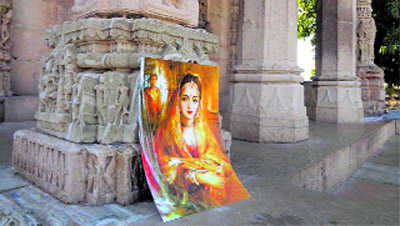
Playing with herstory?: State initiatives for promoting tourism in the Chittor fort too have led to using the site for historicising the story and its central character.
Suraj Bhan Bhardwaj
THE recent vandalism on the sets of the Bollywood movie Padmavati at Jaipur's Jaigarh fort has again pushed history into spotlight for all the wrong reasons. The members of the obscure Rajput Karni Sena, self-styled custodians of Rajput history and defenders of Rajput honour, assaulted the director in protest against the "distortion" of history that allegedly offended their community.
Predictably, the incident garnered considerable coverage in the print, electronic and social media. Opinions have been expressed in terms of defending the freedom of creative expression, condemning the sub-nationalistic tendencies behind the attack, calling for sensitivity to collective historical memories of communities, debating the links between academic history-writing and cinematic representation of historical narratives, and questioning the very historicity of source of the film. Written from the standpoint of a professional historian, this write- up, while touching upon some of these issues, focuses on the story of Padmavati and its transmission in some select sources throughout history.
The tale was first narrated in Padmavat, a long Awadhi poem written in 1540 by Sufi poet Malik Muhammad Jayasi.
The ideals of love, courage and sacrifice in the tale that appeared in several renditions through the centuries. It captured the public imagination to the extent that it came to be regarded as historically true. However, some of the adaptations of the legend added an unfortunate communal colour to it by characterising Padmini as a Hindu Rajput queen who defended her honour against a Muslim invader. The perception of this legend as history has been continually reinforced not only by bards through oral narrations since pre-colonial times, but also by several novels, plays, television serials and movies in modern times. State initiatives for promoting tourism in the Chittor fort too have led to using the site for historicising the story and its central character. Light-and-sound shows in the fort vividly enact the story, and a small, relatively modern-but-dilapidated structure on a lake within the fort is designated as Padmini palace, where a small mirror on a wall is described by the guides as the one in which Alauddin saw Padmini's reflection and became lovesick. The historicity of this popular story when subjected to scrutiny is found to be suspect at the best. Nevertheless, this historically dubious association of the site with an otherwise long and remarkable history dominates the public mind. Creating dominant, at times exclusive historical imagination of sites with multiple histories renders their rich past as rather one-dimensional. While constructed historical perception/memory of a site, event or a person has its own significance for understanding why and how it was cultivated and became popular. It still needs to be distinguished from factually verifiable history. Alauddin Khilji's invasion of Chittor in 1303 AD is a historical event described at length by prominent contemporary Indo-Persian chroniclers, Amir Khusrau, Ziauddin Barani and Khwaja Abu Malik Isami, who neither attributed the invasion to Alauddin's desire for Padmini, nor mentioned Padmini or her jauhar at Chittor. Notably, even Khusrau who accompanied Alauddin in his campaign did not mention the Padmini episode in his eye-witness account. On the other hand, Padmavat was written 237 years after the siege and 224 years after Alauddin's death (1316 AD). Noting the absence of any reference to Padmini in the accounts prior to Jayasi's poem, eminent historians such as KS Lal and Gauri Shankar Ojha, respectively, experts on the history of Khiljis and Rajasthan, dismiss the episode as a figment of Jayasi's imagination and explain the invasion of Chittor, as well as other states in the north and Deccan as a part of the Khilji ruler's ambitious expansionist policy, driven by political, economic and strategic considerations. Historically, wars were and still are a result of complex interplay of several factors, and cannot be reduced to a ruler's personal whims and fancies.
Seventy years after appearance of Jayasi's poem, the story surfaced in Muhammad Qasim Firishta's Tarikh-i-Firishta, with some significant variations. The most notable variation is the depiction of Padmini as Ratansen's daughter not wife. In this version of the story, Alauddin imprisoned Rai Ratansen in Delhi and ordered him to surrender his daughter Padmini. Instead, Ratansen asked her to rescue him. As in Jayasi's story, Padmini came to Delhi, accompanied in palanquins by brave Rajput soldiers disguised as her attendants. They killed Alauddin's soldiers and rescued Ratansen. This version of the story may have been author's own innovation or sourced from a version other than Jayasi's, since the legend probably would have been circulated widely enough to generate several versions. In an early 19th-century colonial ethnographic account, Annals and Antiquities of Rajasthan (1829-32), James Todd offers another re-telling of the legend based on the oral traditions of bards (charan-bhats). In Todd's version, Bhima Singh, the ruler of Chittor, married Padmini, the daughter of Hamir Singh, the ruler of Simhala-dvipa. Alauddin Khalji attacked Chittor to obtain her, but could not conquer it and wished to return after having a glimpse of her in the mirror. When Bhima Singh went outside the fort to see him off, he deceitfully captured him and took him to Delhi, asking Padmini to join his harem as a condition for his release. The rest of the story more or less coincides with Jayasi's version. In the early 20th century, the story was shaped into a popular musical narrative (saang) by a Haryanvi poet and performer, Pandit Lakhmichand. His version, like that of Jayasi, is imbued with a strong element of beauty and love, though both belonged to different traditions, Lakhmichand belonged to the rural bardic tradition and Jayasi to the Sufi tradition. Metaphors drawn from natural phenomena dominate the poetic imagination employed in describing the love of Ratansen (named as Ranveer Sen in Lakhmichand's saang) and Padmini. Unlike Jayasi's poem, Lakhmichand's saang omits the reference to the key historical event, Alauddin's siege of Chittor. Instead, it exclusively focuses on the blossoming love of the two protagonists, their trysts and conversations. Further, it does not describe Padmini as a Ceylonese-princess-turned-loyal-Rajput queen; it ends up as happy union of lovers, not in her self-sacrifice. Tales such as Padmavat have undergone retelling number of times in different cultural settings throughout history. Bhansali's movie, like other movies or literary works on historical themes, can be considered just another re-telling targeted at a certain kind of audience. Those who criticise or support the depiction of history in the movie based on a historical fantasy would be better advised to rationalise their approach to creative media.
The writer is Associate Professor of History at Motilal Nehru College, University of Delhi & the author of “Contestations and Accommodations: Mewat and Meos in Mughal India.”



























